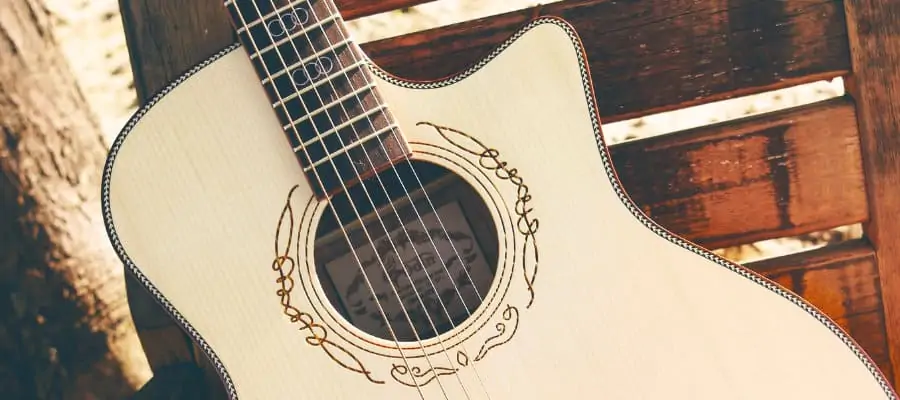If you are an acoustic guitar player, you are probably aware that acoustic guitars usually have a soundhole. The main purpose of the hole is to allow the sound to travel more freely. However, some guitarists put a cover over the hole when they play their acoustic guitar.
So, why guitarists cover the soundhole of an acoustic guitar? The main reason why a player would cover the soundhole is to prevent the feedback created by the soundhole. When you are playing live with an acoustic guitar, you will need to crank up the volume, and feedback can sometimes interfere with your playing.
Interestingly, using a cover will bring a difference in the tone as well. So, do you need one?
What Is The Purpose Of The Soundhole In A Guitar?

If you take a look at the string instruments, acoustic ones will usually have a soundhole. This hole is an opening on the body of the instrument and its purpose is to improve the quality of the sound.
Furthermore, soundholes will allow the instrument to project the sound more efficiently. Whenever you play a note, the soundbox will vibrate, and the airflow will travel through the hole.
There are many types of soundholes, and you probably know about the circular and f-shaped holes (like on a violin).
What Do Soundhole Covers Do?

These covers are designed to remove the feedback on electric acoustic guitars with Piezo pickup which is also known as electric acoustic guitar. So, if you have a guitar without any pickups, that can’t be plugged in, you don’t need a cover.
If you are not quite sure what are electric acoustic guitars, you can check out my post What Is An Electric-Acoustic Guitar And How It Become Popular?
Unless you have neighbors or roommates that complain about your playing and you want to lower the volume of your acoustic guitar. But it isn’t the main purpose of the soundhole cover.
When it comes to soundhole covers we need to make a distinction between the two types of acoustic guitars. Those that have a Piezo pickup, (electric acoustic guitar) and those who don’t.
An acoustic guitar that doesn’t have a pickup and can’t be amplified relies on its acoustic abilities. Therefore, in order for you to amplify it, you will have to place a mic near it. Needless to say that the last thing you would want is to cover its soundhole and create a muffled sound.
On the other hand, we have an electric acoustic guitar that has a pickup in it. While playing it when it is plugged in, it creates feedback.
While you can cut some frequencies on the equalizer or on the mixing desk, sometimes you might find yourself in a situation where you need a certain sound from your guitar. This means that you can’t change anything (or lower the volume).
What happens when you start playing the guitar, the whole soundbox starts vibrating. Naturally, it’s not something that is obvious for the viewers, but all acoustic players are well aware of the vibrations that happen on their instrument.
When you amplify the sound of the acoustic guitar, it will resonate and pick up the sound coming back from the sound system. As a result, you might hear the shrieking sound coming from the speakers or more commonly – feedback.
What this cover does is it stops the airflow through the soundhole and prevents the sound from being amplified again in the soundbox of the guitar.
If the same frequency is coming from both inside of the guitar and outside of it, it will create feedback. By blocking the soundhole while playing live (or plugged in), you can prevent more than 80% of the feedback, and thus improve the sound of your instrument.
Why You Should Consider Using A Soundhole Cover

If you are playing the guitar by yourself, you have absolutely no need for a cover for guitar’s soundhole. However, if you plan on playing live, this might be a good investment.
This applies especially to anyone who is playing with a higher volume. At this kind of setting, feedback from the instrument might be too much to handle, and covers are used to change that for you.
Furthermore, if you are wondering about the looks of the instrument, you’ll be delighted to know that you can get covers for soundhole in various designs. This way, you can find the one that you like the most and that will improve the look of your beloved instrument.
The main reason why feedback might be a problem is especially apparent if you are playing alongside other musicians.
For example, if your in a band that has an electric guitar, bass, and drums, you will need to crank up the volume of your acoustic guitar if you want the audience to hear you at all.
Furthermore, when you play an acoustic guitar plugged in, feedback is something that you should think about because of the shrieking sound it creates.
Naturally, the sound is different when you play the guitar with a soundhole cover, but it is something that you should learn to deal with if you will be playing live.
If you are interested to hear the difference you can check the following video that compares the difference between playing with or without the cover.
How To Install The Cover?

If you found yourself in a situation where you need to stop or prevent the feedback, you can install these covers quite easily. Naturally, there are many types of covers available on the market, and you can get various designs and materials.
Usually, the most common and the cheapest type is made of rubber. This allows you to install it or remove it in no time.
For example, if you want to place the cover on the acoustic guitar, you will just slide it under the strings and place it tightly on the soundhole. The best thing about these covers is that you don’t need to remove the strings or do any other kind of setup.
The only thing you need to do is slide it in, and put it in the soundhole. Furthermore, removing them is even easier. You will just remove it from the soundhole, and since the rubber is elastic, you won’t have to worry about the damage to either the instrument or the cover itself.
One of the advantages of these covers is that you can place them in when you play live, and remove them when you need the acoustics of the guitar. After you put the cover on the soundhole, you will proceed to play as you would without the cover.
You might need some time to adjust to the additional rubber over the hole, but it won’t cause you any trouble or discomfort.
Downsides Of Using A Cover
By using the cover you will stop or prevent the airflow in and out of the soundbox. The first and most obvious difference is that the volume will go a bit down.
The second thing is that the cover will cut some frequencies as well. However, these things are not as important since you will use it only and only when you play the guitar via an amplifier.
If you are practicing alone, there is no reason to use it at all.
How To Pick The Right Soundhole Cover For Your Acoustic Guitar?

The first thing you should check is the size of the soundhole. Even though most of these feedback busters are made of rubber, you should still find the one that fits your instrument.
Unfortunately, the soundhole size is not something that’s standardized, and it is still possible to find a guitar where you won’t be able to fit some of the covers. Most of the feedback busters available on the market are designed for 4” soundhole. So, if the soundhole of your guitar is 4” or 10 cm, you can pick almost any of the covers available in your local store.
The other common size of the soundhole is around 95 mm, or 3.74 inches. It is still possible to find covers for this size, so be sure to check the size before proceeding to buy a cover for your instrument.
The second thing you should consider and decide is what kind of design or material you want. For example, the majority of busters are made of rubber, but you can find ones made of wood with a unique design. Naturally, you will need to pay slightly more for later ones.
Lastly, if your guitar has a soundhole with an unusual shape, you will have to look for that unique feedback buster. Fortunately, manufacturers of the instrument often offer a feedback buster as well, so you should check their website first.
My Top Soundhole Covers
Here, you can see the most popular and most common soundhole covers available in most music shops.
Planet Waves Screeching Halt
- ELIMINATE FEEDBACK AND ENHANCE STAGE VOLUME with the D'Addario Screeching...
- QUICK AND EASY TO INSTALL AND REMOVE without any tools required
- SOFT RUBBER INSERT ensures a secure fit and won't damage your guitar's...
- FITS MOST STANDARD 4" SOUND HOLES for versatile compatibility with various...
Among the most popular soundhole covers is undoubtedly the one designed by Planet Waves.
Their Screeching Halt model will fit most acoustic guitars, and you can install it or remove it in a matter of seconds.
The cover is made of rubber, so you won’t have to worry about any damages to the finish of the instrument.
Fire Wooden Soundhole Cover
The second type is perfect if you are looking to install something beautiful and exciting.
It has an amazing wooden design on an aluminum and foam feedback buster. it’s the standard 4” in diameter that will fit most acoustic guitars.
Conclusion
Covers for soundhole of the acoustic guitar are an incredible way to reduce the feedback or even to completely eliminate it. While you might adjust the volume and EQ, it can prove to be too much work in the end.
It is so much easier to simply place the cover over the hole, and enjoy playing with higher volume. The best part about these covers is that they are cheap, and you can mount them on almost any guitar.
Just be sure to check the diameter of the soundhole to get the appropriate cover.
If you found this article useful, you may want to save this pin below to your Guitar board.

Last update on 2025-12-15 / Affiliate links / Images from Amazon Product Advertising API
2 thoughts on “Why Guitarists Cover The Soundhole Of An Acoustic Guitar?”
Leave a Reply
Recent Posts
When learning new songs have you noticed that some of the chord sequences sound really good? But when you tried to come up with your own chord sequence, or as we call it chord progression, you found...
Some guitarists insist on buying an expensive amplifier with their electric guitar. They assume that this is a must for every type of guitarist out there. However, in some situations, this isn’t...


Hello Jacob
I always enjoy hearing from those who look into the finer aspects of their musical instrument, so few do. Knowledge and understanding enhances the relationship one has with one’s instrument, and in turn enhances ability. I have over the years done a great deal of research and study in the world of acoustic guitars to me probably my greatest personal love, like people no two ever exactly the same. By now at seventy seven I think I have acquired a fair understanding on the subject. My love affair with the acoustic guitar started when I was eleven. When I hear people speak of the hole on the top of the guitar and refer to it as the sound hole, I usually have a little smile. Yes the hole dose make a difference mainly in volume but that is not it’s main function. Sound is vibration when you are playing the guitar the vibration goes into the guitar does a little dance inside is reflected off the back, looking for escape heads to the top with the sound going into the top and in turn escaping out through the top that top is vibrating like crazy. The guitar is pumping the air again like crazy so this requires free flow of air and that is the primary purpose of the hole therefore a more accurate term would be air hole not sound hole. I recall years ago most people I knew referred to it as air hole but that seems to have changed over the years. I was reading some of your articles and thought to share this with you. I don’t have a taste for electric guitars or rock, I’m in the land of contemporary – folk – blues – some country but although we’re not in the same room it’s still the same house. A music lover is a music lover no matter which window ones’ looking through. It always makes me feel good when I here someone enjoying their journey with music. Keep up the good work.
Friend in music – JB Seguin
WOW! I’m speechless…
Thank you for sharing that with me.
I really enjoyed reading it! You made my day.
Sorry for replying so late, for some reason it filtered as spam.